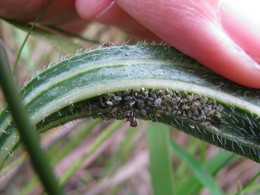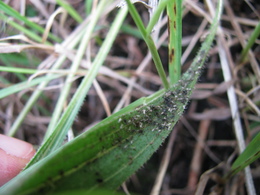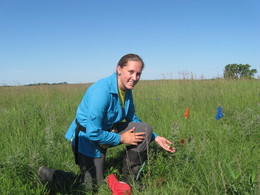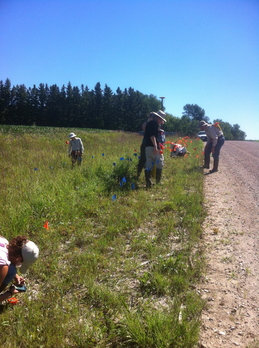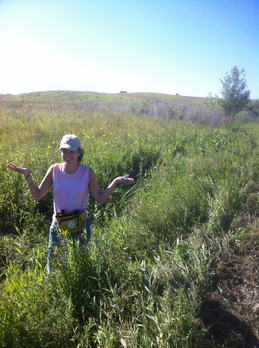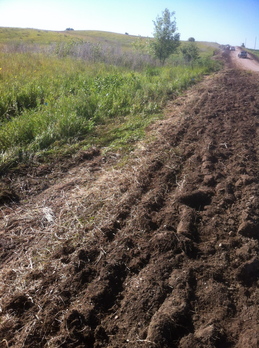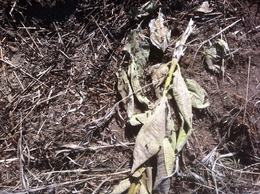At 6:30 this morning we piled into the car, headed to the University of Minnesota in Minneapolis, and presented our posters. Although the symposium was dominated by pre-meds, it was a good experience for us to explain our research to undergraduates with different focuses. Next week Andrew and I are off to Chicago to present again at the Chicago Botanic Garden.
Here’s a picture of all of us at the conference:
|
||||
|
It was a dark and stormy morning. With the exception of Jill, Maria, and I, the members of team Echinacea bided their time at the old town hall waiting for the rain to diminish. The three of us had indoor tasks to work on–specifically, sorting ants and entering data. After the sky had exhausted itself, a group of us went to a large site at East Elk Lake Road to search for flowering plants for the annual Echinacea demography census. We had searched the site before, but the cloud cover made prime conditions for finding Echinacea among the shrubs and trees. Stuart, Maria, and Andrew went to another large and difficult-to-search site (Aanenson) to take GPS points on plants. After that, several of us began censusing Riley, a roadside remnant. The site is full of flowering plants, many of which are growing in the road. Because of this, many of the plants have lost their heads due to mowing. The team finished Riley in the afternoon, leaving enough time to census a nearby site we call Woody’s. I spent the afternoon excluding aphids from plants in my aphid addition/exclusion experiment. Aphid infestation is clearly on the decline for the season. Each time I perform aphid exclusion, I record the number of aphids present on the plant before I remove them. This time yielded the lowest aphid counts in my exclusion group this summer. I haven’t crunched the numbers yet, but based on my exclusion data I estimate that the peak of aphid season was probably between July 25th and August 1st. That is much earlier than last year, when the peak was between August 12th and 26th. Last Saturday when I was performing aphid additions, I noticed that a lot of the plants in my addition group had colonies of dead aphids. For example, one plant that hosted nearly 2000 aphids on July 21st was down to 7 last Saturday. For an idea of what this transformation looks like, here’s a picture of a dense, thriving aphid colony: And here’s a picture of a colony that has died off: It is unclear why this happens so suddenly, considering the plant is still green. My guess is a surge of defensive chemicals in the plant. On Thursday, all the undergraduates are going to the University of Minnesota for a poster session. They all did a great job on their research projects and put a lot of time and effort into their posters. I wish them all good luck in their presentations and look forward to hearing about their experience. Here’s all of my data from my crossing experiment and the R script that I used to analyze it! I’ll put up a metadata sheet soon. Hallo once again from K-town! It was yet another wonderfully nice day out in the prairie of Minnesota. This morning, Maria and Katherine headed out to the Landfill site to GPS all of the flowering plants we found earlier (about 80 of them this year). Kelly, Jill, and I headed over to Around Landfill to do demography on the plants Kelly used for her phenology project. And Shona and Andrew won (at long last) a battle with our second GPS unit (which arrived yesterday), Chekov. Chekov has come to join Sulu in our endeavors to gain coordinates. But it’s best if both work properly. Oh, and Kelly’s last plant at all her remnants finished flowering today! It’s bittersweet. I’m really excited to present on Thursday at the U of M! Come check it out.PolEfficiency2012_small.pdf Title: Examining Pollen Limitation in a native prairie panic grass, Dichanthelium leibergii It has lots of cool pictures and Dichanthelium as the background! 🙂 See you at the symposium! Here’s the poster I will be presenting at the University of Minnesota on Thursday. Here’s a copy of the poster that I submitted for the poster session at the University of Minnesota. It has some preliminary results as well as a list of future data analysis that I want to complete. What a day! The kitchen at Town Hall was busier at 7:20 this morning than I’ve ever seen. It seems like everyone had the same idea to get up early and give their poster one last look before submitting it for printing. Thankfully we all got our posters in on time and we are enjoying a nice reprieve from poster-work this evening. At work today, we completed demography on East Riley. There were lots and lots of flowering plants within a meter or so of the road that had been mowed and did not get chance to flower this year. In the afternoon, we worked on more demography at East Elk Lake Road and Around Landfill. In the morning, Stuart told us about some roadwork that was happening along the Douglas-Grant County line by our Landfill sites. Katherine, Jill, and I stopped by to check it out. It looks like the road workers have dug up about 3 meters of roadside along the North-northwest of Landfill site. On the positive side, it’s lucky that this is happening after the plants had finished flowering, but on the negative side, one row of Jill’s pitfall traps have been buried. We met some of the construction workers who told us that they were working to improve the drainage of the road by evening out the roadside ditches. He also showed us the seed they were replanting: a mixture of brome, timothy, alfalfa, and clover among other things. I guess this is a prime example of the habitat fragmentation and altered disturbance patterns that we’re here to study. It’s hard to watch the plants go, but in the long run these disturbances and our ability to monitor if/how the plants recover will teach us how to better manage prairie remnants in order to maintain stable plant populations. Here is my poster for the University of Minnesota symposium. I may make some changes for the Chicago Botanic Garden symposium, but that depends on how much more data I get through by the 17th. Jillian Gall_REU Poster_Small.pdf |
||||
|
© 2024 The Echinacea Project - All Rights Reserved - Log in Powered by WordPress & Atahualpa |
||||

